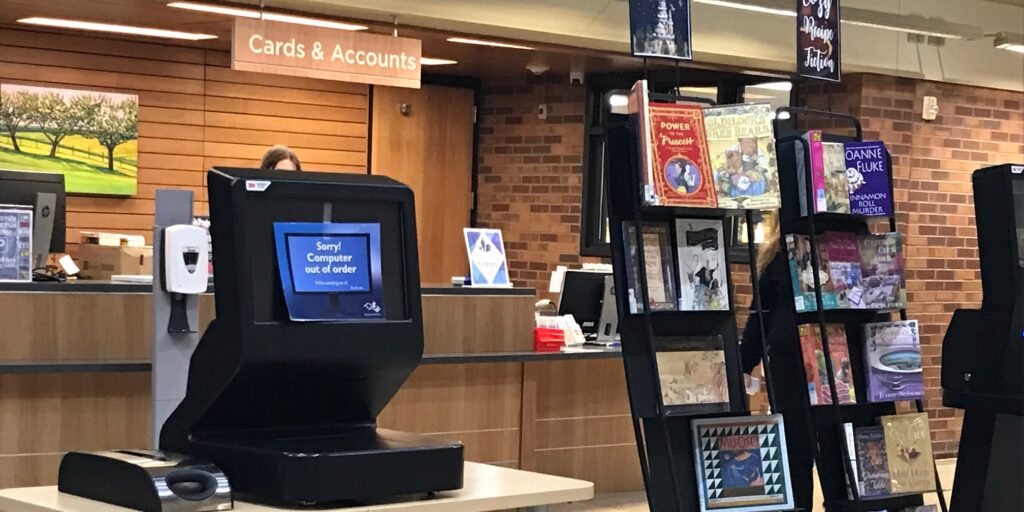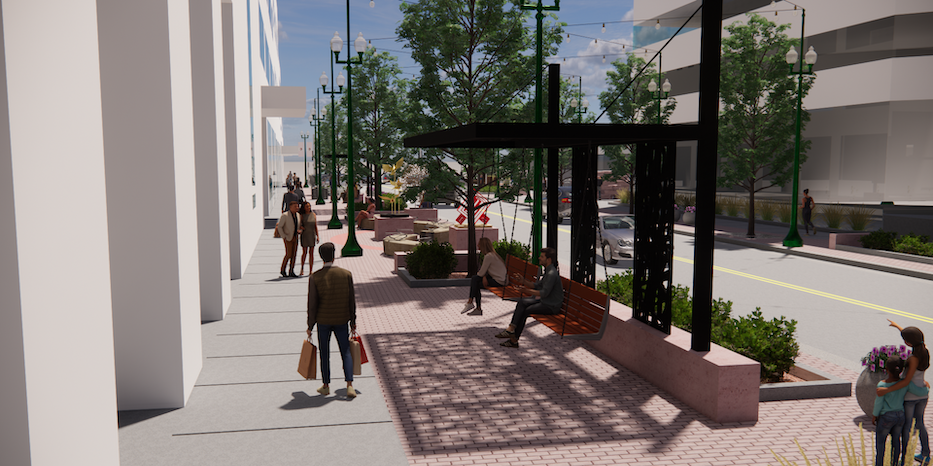Preserving dark past becomes mission for keepers of Hiawatha Asylum’s story
By Steve Young, for Pigeon605
They say it was a place of madness, a government experiment in institutionalization where the paranoid and the insane would be protected – and the world protected from them.
East of Canton along the Big Sioux River, it was called the Hiawatha Asylum for Insane Indians. But those who know intimately the history of that institution remember it as something else – as one of the darkest chapters of abuse and despair South Dakota has ever known.

Built for $42,000 at the urging of U.S. Sen. Richard Pettigrew, the Hiawatha Asylum took in between 350 and 400 indigenous people from across the country after it opened in 1903. Thirty years later, when it was ordered closed and its records sealed for seven decades, at least 121 graves were left behind in the asylum cemetery.
Buried there, too, was the truth about men and women who were not insane. The truth about people who were sentenced to Hiawatha for nothing more than being epileptic, or alcoholic, or recalcitrant because they would not abandon their Native culture and practices.
“To read the records of this place now after coming off a 70-year gag order from the judge that closed it down, you find people’s ancestors were sent here, and no one even knew it,” said Jerry Fogg, a Yankton Sioux artist who is part of a group – the Keepers of the Canton Native Asylum Story – that is intent on preserving the memory and stories of Hiawatha.
“They diagnosed these people wrong. They fed them wrong. They sent them into the asylum wrong … wrong, wrong, wrong, wrong,” Fogg continued. “Somebody has to let the people know about it. That’s what we’re doing. You know, it’s the old saying, ‘If you don’t know about history, you end up repeating it.’ ”

In today’s era of shootings and mass death, of communities grieving and promising to never forget those lost, the Keepers of the Canton Native Asylum Story are working to keep that promise every day. Their mission is simple: “To come together as human beings to honor the people, to enhance and embrace Education, Preservation and Reconciliation for all those affected by the Asylum.”
Comprised of roughly 10 Native and non-Native members, the Keepers have spent the past decade doing that by:
- Hosting an annual honoring and remembrance gathering at the cemetery, which is surrounded by a fence and sits today between the fourth and fifth fairways of the Hiawatha Golf Course that now occupies the former asylum grounds.
- Doing outreach through talks and programs to educate the public about the asylum and what happened there.
- Reaching out to 53 tribes and their historic preservation offices that have ancestors buried at the cemetery to let them know about the honoring ceremonies and repatriation options.
- Working with the city of Canton and golf course management on improving the fencing around the cemetery.
“We’ve had a discussion about the entrance, too, doing some kind of plaque that gives a brief history of it, so when people come to the course and see it, that’s there to help explain it,” said Ross Lothrop, a Citizen Potawatomi tribal member who is part of the Keepers.

These dolls were made by residents of the asylum, many of which are on display at the Canton Public Library.
The truth about the asylum’s life span from the dawn of 1903 to Christmas 1933 lies somewhere in the newspaper clippings trumpeting the job creation and economic development bestowed upon Canton and the government documents that detail the abuse and despair at the facility.
Those records indicate that asylum doctors relied on nine diagnoses – dementia praecox, epilepsies, congenital imbecility, intoxication psychoses, manic-depressive insanity, senile psychoses, arterio-sclerotic dementia, hysteria and paranoia – as justifications for keeping patients at the institution. Records suggest that many of those diagnoses did not apply, and the reality was that those sent to Canton seldom left the facility except through death.
Patients were locked overnight in their rooms with uncovered chamber pots filled with urine and excrement, according to government records. They slept on sheets blackened by coal dust that covered the floors. Isolated, many endured years of mistreatment.
In 1988, a Lakota man named Harold Iron Shield started a healing and prayer service at the golf course cemetery that continued for two decades until his death. A Yankton Sioux, Lavanah Judah, picked up the honoring ceremony after Iron Shield died. Now, the Keepers host the annual ceremony and, with government records in hand, have been reaching out to tribes across the country with ancestors buried at Hiawatha.

A monument in the cemetery listing the names of Native people who died at the asylum and are buried in its cemetery.
A few of those tribes responded, Lothrop said. The Gila River Indian Community from Arizona sends a group every year, he said. The Sisseton-Wahpeton and Rosebud tribes have reached out to the Keepers and attended the gatherings. One year, a tribal lacrosse team traveling the country showed up for an honoring ceremony. The Sacred Horse Society, with connections from the Rosebud and Wagner areas in South Dakota and the Santee area in Nebraska, has participated as well in the ceremonies, attending on horseback.
“Lower Brule, one of its educators has come up with his family,” Lothrop said. “Marty Indian School … we had a connection there. They brought a whole busload of high school and middle school kids. And we’ve had another tribe from Arizona that came up.”
A tribe in Oklahoma actually repatriated the remains of one of its ancestors from the cemetery in 1982, Lothrop said. That is the only tribe so far to do so, though several other tribes have reached out to the Keepers about the process and work needed to make it happen.
Repatriating has it challenges, Fogg and Lothrop said. “You might have a Sioux, who might be next to a Cheyenne, who might be next to a Potawatomi, and they all have different spiritual practices,” Lothrop said. “And there’s a belief that if you disturb the body, they’re never going to complete their journey, so Jerry and I always talk about those issues.”

That said, the Keepers, the city of Canton and the golf course all believe in tribes’ right to repatriate, he said. To help with that possibility, the Choctaw Nation in Oklahoma brought ground-radar capabilities to Canton in 2016 to identify anomalies in the soil that would represent graves. Though there are government records and a plot map on who is buried there, some anomalies have no names associated with them, Lothrop said. So his group is hoping to have more ground-radar work done to help bring more clarity.
“That’s kind of one of our first goals,” he said. “We would like the ground radar back so we can identify each anomaly and then put down metal stakes, like rebar, so we can go along with a metal detector and hit every one of those anomalies and better match each one up with a plot map that we have.”
A second goal is to put new fencing around the cemetery. There was talk once of replacing the rectangular wooden fence with a circular one that captures tribal beliefs in the circle of life. Unfortunately, Lothrop said, a circle would impede too far into the adjacent fairways, so now they’re discussing the potential of an oval-shaped fence.
That won’t happen until money is raised to pay for it, but Lothrop said his conversation with the golf course board and others leads him to believe that “it’s going to happen.”
That said, there are many things taking place on the education front. Zeke Hanson of Sioux Falls has a film and television production company called Lights Out Productions that is in the process of making a documentary on the asylum.

Photo by Zeke Hanson
A graduate of Canton High School, Hanson first heard about Hiawatha from a civics teacher. Four years ago, after a friend invited him to attend an honoring ceremony at the cemetery, the idea for the documentary blossomed.
Since then, he has interviewed three old-timers from Canton who remember when the asylum was open, about the jobs it brought to Canton and the stories of people they knew at the institution. He has captured conversations with six tribal members from South Dakota as well, people who are interested in exhuming the remains of their ancestors or are just looking for closure on the lives of distant relatives they never knew.
Hanson hopes to interview a tribal member in New Mexico as well and potentially several with the Oneida tribe in eastern Wisconsin before he is through.
“As I see it,” Hanson said, “the whole purpose of what I’m doing is so that more people can be aware of this asylum, can understand what happened there, but also what people are still trying to do.”

This image was shot by Zeke Hanson when members of the Sacred Horse Society rode into Canton on horseback to be part of an annual honoring ceremony on the grounds of the former Hiawatha Asylum.
He said he has an ongoing series with South Dakota Public Television called “Step in My Studio” where the finished documentary potentially could air. He also wants to show it at international film festivals and said he would be ecstatic if his work, which he hopes will be finished a year from now, could get into schools and other public settings.
“Ross, Jerry and the Keepers have been a huge help,” Hanson said. “There’s only been a few books written on it, so the Keepers have done all the heavy lifting by doing all the archival searches already. Because of them, I had so much information. And it’s nice, if I have questions, I can ask them, and they can answer them or point me in the directions of other people and make introductions. Without them, I never would have been able to start.”
That documentary will be invaluable to their education and preservation work, Fogg and Lothrop insist. Fogg has created several pieces of art that capture the asylum’s story as well, and he will take them with him when he and others among the Keepers are asked to make presentations on the asylum’s history. Lothrop likewise drops off flyers at schools and other public places and continues to contact tribal offices, hoping to get in the door to share the story.
And that’s not all. The food service at the Hiawatha Golf Course has created a trifold menu with a brief history of the asylum on one of the folds. The Keepers also have used remnants from the asylum to create a special entrance to the golf course, with a dream of creating a plaque to place there that captures some of Hiawatha’s unique history.

The entrance to the Hiawatha Golf Course in Canton includes stones and other artifacts from the asylum.
All those efforts, Lothrop and Fogg believe, hopefully will keep the story, the memory, of the Hiawatha Asylum alive for years to come.
“We haven’t made as much progress as we’d like; you never do,” Fogg said. “But I’ve been told, and I’ve got a feeling, that a lot more people’s ears have been opened. Whether they remember it or want to remember it is their decision. But we’ve kept that place alive through every event we’ve had through these last 10 years. We’ve opened some ears. And we’re not done. Not by a long shot.”
To learn more
The Keepers of the Canton Native Asylum Story will tell the history of the Hiawatha Asylum that once operated in Canton. The presentation will begin at 7 p.m. Thursday, Nov. 9, at Good Earth State Park at Blood Run. It is free to attend with a South Dakota state park entrance license.
Share This Story
Most Recent
Videos
Want to stay connected to where you live with more stories like this?
Adopt a free virtual “pigeon” to deliver news that will matter to you.





























